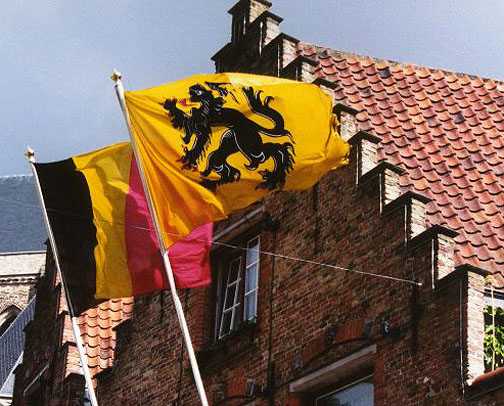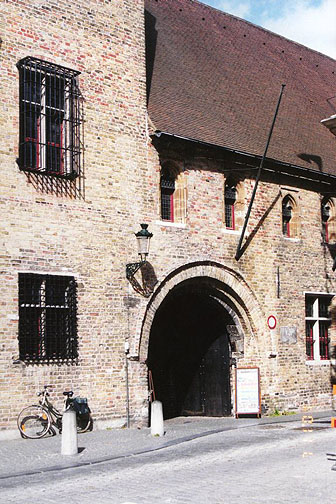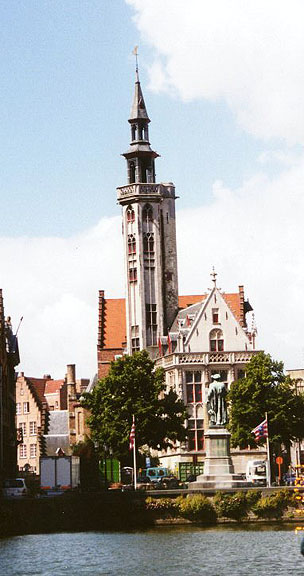

Bruges

Belgium flag and the Flemish flag (one with the black lion)

Romanesque entry
Brugge, city in northwestern Belgium, capital of West Flanders Province, near the port of Oostende. Several railroads serve the city, which is also connected by canals to Oostende, Ghent (Gent), and the port of Zeebrugge. Important economically to Brugge are the manufacture of fine lace, a product for which the city has long been famous, and the large number of tourists attracted by the city's medieval character. Other industries are textile and chemical manufacturing, brewing, and shipbuilding.
bridge over the canal
Points of interest in Brugge are the more than 50 bridges that span the canals in the city and that can be opened to permit the passage of ships. Among the many medieval buildings in the city are the 13th-century Halles, or marketplace, with a belfry 108 m (353 ft) high; the Cathedral of Saint Salvator (13th-14th century); the 12th-century Chapelle of Saint Sang; the 12th-century Hospital of Saint John; the 13th-century church of Notre Dame, with a 122-m (400-ft) tower; and the Hôtel de Ville, the oldest town hall in Belgium, begun in the 14th century.
Virgin and Child (1501-1505)
a marble sculpture attributed to Michelangelo,Among the art treasures of the city are Virgin and Child (1501-1505), a marble sculpture attributed to Michelangelo, and the chief paintings of Hans Memling.
the cathedral
During the 9th century Brugge was fortified by the counts of Flanders. At that time the town was linked to the sea by the Zwyn River, and during the next four centuries its importance as a port increased steadily. Brugge became a member of the Hanseatic League about 1340.
Shrine of the Holy Blood
Guild buildings along the canal
The city, then one of the leading trade and woolen-goods manufacturing centers of the world, flourished until the end of the 15th century. About that time, it began to decline, primarily because of the closing of the Zwyn River by accumulated silt. As a consequence, the weaving industry disintegrated, and the guilds collapsed.
canal
locks to regulate the water levels in the canals
Brugge never regained its former preeminence as a trading and manufacturing center, and before the end of the 16th century it was known as Bruges-la-Morte (French for "dead Bruges"). From 1795 to 1814, during the French Revolution and the Napoleonic Wars, the city was ruled by France.
along a canal
as seen from the canal
It was a possession of the Netherlands from 1814 to 1830, when Belgian independence was established. Construction of the canal between Brugge and Zeebrugge early in the 20th century considerably accelerated commercial activity in the city.
an example of Art Nouveaux
At the same time, city leaders took steps to preserve Brugge's dramatic architecture, which had survived largely intact from the city's period of commercial dominance. German military forces occupied Brugge from 1914 to 1918 during World War I and again during World War II from 1940 to 1944.
restaurants to serve the tourists
Today the city is one of the biggest tourist attractions in Belgium, and is considered one of the best-preserved medieval cities in Europe. Population (1991 estimate) 116,717.
Text from Microsoft Encarta

The mediaeval lodge of
the citizens of Bruges.
In order to be able to work, or trade in the city
during the Middle Ages you had to acquire citizenship.
On one of the walls is a statue of a bear, known locally as "the bear of the
lodge". According to folklore, the founder of the city encountered this bear
when he first came to this site looking for a convenient place to start a new
settlement. This bear is regarded as the city's first inhabitant.
The bear is the symbol of Bruges.
![]()
![]()